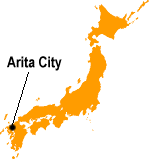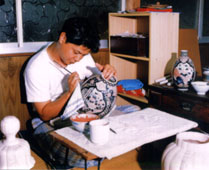

 |
||

|
Colorful Art from Japan's Oldest Porcelain
Kiln
 Arita ware originated in the beginning of the 17th century when layers of kaolin, the main component of porcelain, was discovered and the first porcelain kiln was built in present-day Arita Town, Saga Prefecture. Arita ware is also called Imari ware because the products of the Arita kiln were mainly shipped from a nearby port of Imari. Arita porcelains of the early days were typically made
in the Chinese style of the period, with deep-blue patterns on a white
background, called "sometsuke." In the 1640s, a new style called "aka-e,"
which was characterized by bright colors and bold patterns principally
in red, was invented. These two styles, "sometsuke" and "aka-e," dominated
Arita-Imari ware. The products of the 17th and 18th centuries are typically
called "Ko-imari" (old Imari), and their important artistic value attracts
both experts and collectors. Arita-Imari ware was exported to Europe in
large quantities through trade between Japan and the Netherlands in the
mid-17th to mid-18th centuries. These beautiful pieces of white earthenware
from the Orient won tremendous acclaim in Europe and influenced the European
porcelain industry.
Today in Arita Town, tableware and other products for daily use are mass-produced in factories, while fine pieces of arts are still created by ceramic artists. The Arita Ceramics Fair is held every spring, when over 650 stores and stalls line the 6-kilometer (3.7-mile) stretch of road, attracting some 700,000 visitors from all over the country. Photos: (From top) Coloring an Arita jar; a kiln in Arita; Arita Ceramics Fair. (Saga Prefecture) Unauthorized reproduction of the
photos in this page is prohibited.
Related Links: |
|

